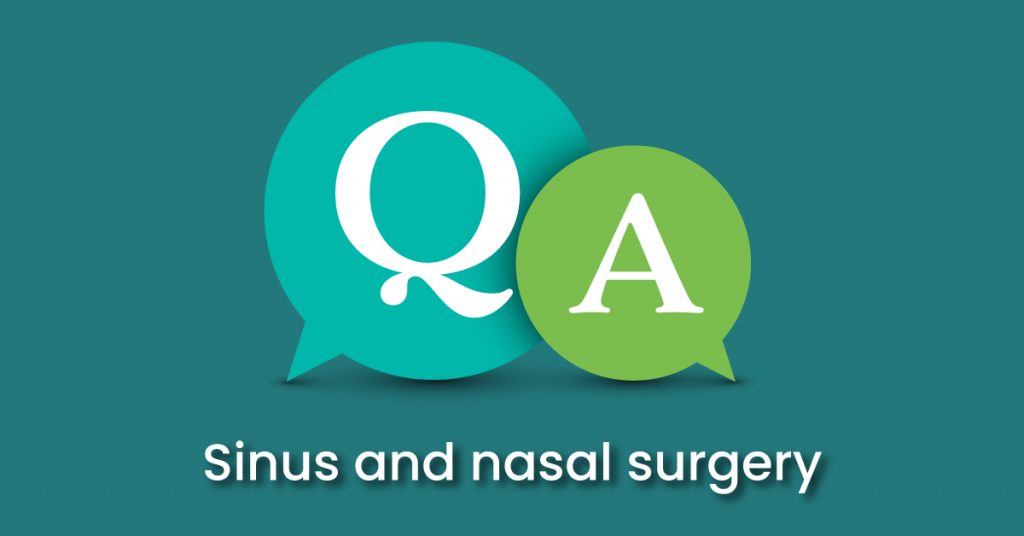Dr. Bradley Johnson answers common questions about balloon sinuplasty and traditional sinus surgery
If you’re dealing with nasal obstruction, nasal polyps, chronic sinusitis or eustachian tube dysfunction, sinus surgery or nasal surgery may be an option to provide you lasting relief.
Learn more about balloon sinuplasty, eustachian tube dilation and traditional sinus surgery procedures from Dr. Bradley Johnson, a board-certified otolaryngologist with Oakdale Ear, Nose & Throat Clinic who specializes in helping patients through minimally-invasive sinus surgery.

What is sinus surgery or nasal surgery? What is eustachian tube dilation?
Sinus surgery or nasal surgery and eustachian tube dilation surgery are types of surgeries performed on the sinuses, eustachian tube, and structures of the nose. This can be done under general anesthetic, a local anesthetic, or a local anesthetic with IV sedation.
Both newer sinus surgeries that use balloon technology, called a balloon sinuplasty, and more traditional methods performed in an operating room are considered outpatient sinus surgeries.
What does typical nasal surgery or sinus surgery involve?
Sinus surgery using balloon technology can be performed in the office, using a local anesthetic with or without IV sedation. A balloon catheter is inserted into the narrowed sinus opening and inflated for a few seconds to enlarge the obstructed sinus opening by moving very thin bones.
What does typical eustachian tube dilation involve?
Eustachian tube dilation is a procedure where a balloon is inserted into the eustachian tube, which connects the middle ear to the back of the nose and throat, through the nose. The Eustachian tube allows the ear to equalize pressure from behind the eardrum to the outside environment. The nose is anesthetized, then the balloon is inserted. The balloon is then inflated for two minutes and then deflated and removed. This allows the eustachian tube to function more effectively to relieve constant pressure and fullness or fluid from behind the eardrum.
What does typical sinus surgery or nasal surgery involve with more traditional methods?
Traditional sinus surgery or nasal surgery is performed in an operating room, under general anesthesia. Bony partitions are removed to enlarge the sinus opening.
What types of conditions can sinus surgery or nasal surgery treat?
Sinus surgery or nasal surgery can treat chronic sinus infections, chronic sinus inflammation, nasal polyps, and help people breathe better through their nose.
What types of symptoms would eustachian tube dilation treat?
Eustachian tube dysfunction gives symptoms which involve fullness and pressure within the ears; the inability to equalize pressure when flying or swimming; popping and clicking within the ears; and in some cases, hearing loss and ringing or buzzing within the ears.
How do you determine whether someone is a good candidate for a balloon sinuplasty versus traditional sinus surgery?
This is partially determined with a CT or CAT scan. If a blockage is severe, or the septum is severely crooked or deviated, traditional surgery may be required.
Patient preference also plays a big role. Patients who want a local anesthetic can have the balloon sinuplasty. Others want general anesthetic, which is used in traditional surgery.
Are there alternatives to sinus surgery or nasal surgery to treat conditions like chronic sinus infections, polyps, and the inability to breathe through the nose?
We always try non-surgical treatments before surgery. Medications like steroid nasal sprays, antihistamines, allergy shots or allergy drops can be helpful. So can saline irrigations or rinses.
If those treatments aren’t improving the symptoms significantly, surgery often brings about the greatest improvement in the shortest amount of time.This is due to the ability to alter the structural defects within the nose and sinuses.
Why does sinus surgery or nasal surgery interest you as a physician?
The changes it brings to the patient are oftentimes dramatic. You can take the most severely affected patient who can’t breathe through their nose, and after a 45-minute, in-office procedure, they can breathe through their nose. Some of these patients have not been able to breathe freely through their nose for years. That’s the most dramatic outcome.
It depends on the patient, the procedure, and the issue it’s treating – but most people feel really good within a week of sinus surgery or nasal surgery.
When should someone consider making an appointment with an ENT specialist, whether they’re interested in surgery or non-surgical treatments?
When they feel they aren’t at the place they want to be, whether it’s not being able to hear as well as they should; not being able to breathe through their nose easily; they have concerns about possible sleep apnea or recurrent ear or tonsil infections; or always being miserable because of allergy symptoms.
They should especially consider an appointment if their issue has been getting worse.
What should a patient expect from a consultation to see if sinus surgery is a good option for them?
We typically look in their nose with what’s called a nasal speculum, which is a very non-invasive way of looking. Sometimes we’ll look a little deeper by putting a little scope inside the nose.
For some patients, we obtain a CT or CAT scan of their sinuses, which takes 40 seconds. That’s very helpful because it tells you the whole story, and it’s easy for the patient and I to look at the images together and see exactly what’s going on, and then discuss how to correct this.
What should patients expect from sinus surgery using balloon technology? What is the recovery time for a balloon sinuplasty?
The patient comes into the office and we give you some oral medication to make you tired, then we topically numb the inside of the nose. Occasionally IV sedation is also given. We’ll insert the balloon inside your nostril and into the obstructed sinus opening while visualizing this process with a very small scope. The balloon is inflated for a few seconds, then the balloon is deflated and we remove it.
We usually have a conversation with the patient during the procedure, chatting about normal things, and every now and then we’ll say something like, “You’ll have a little pressure here.” The procedure takes about a half-hour.
The patient will go home. We will ask patients to stay upright and not do anything that day, because there will be some bleeding, and that helps the bleeding stop more quickly. The next day, they’re usually feeling really good. There is some nasal congestion the day after surgery, oftentimes with little to no pain.
What should patients expect from traditional sinus surgery or nasal surgery? What is the recovery time for traditional sinus surgery?
Since you’ll be under general anesthesia, you’ll first need a physical examination from your primary care doctor, and you can’t eat the night before.
The day of the surgery, an IV will be inserted to deliver medication that puts you to sleep, and an endotracheal tube will be inserted to breathe for you once you are asleep.
We perform the surgery through your nostrils while you’re completely asleep. It takes an hour to an hour and a half. You’re very groggy when you wake up for about 45 minutes to an hour, but you’ll still go home that day.
There’s some pain, bleeding, and stuffiness for about three to five days afterward.
Does anything often surprise patients about sinus surgery or nasal surgery?
Often it’s not as bad as they thought it would be. Years ago the recovery was terrible, back when doctors would pack the nose with big packs. This would produce a severe amount of pressure within the nostrils. Things have gotten much better in the last 15 years, with newer techniques and technology that make recovery much easier, making nasal packing unnecessary in almost all cases.
Does sinus surgery change the outward appearance of the nose or leave your nose black and blue?
No, sinus surgery does not change the outward appearance of the nose. I think that belief goes back to older sinus surgery techniques that are no longer used, or online videos of people who have said they had sinus surgery but had a different procedure, such as a rhinoplasty. If you’re all black and blue right after surgery, that means you had a rhinoplasty, which is different than sinus surgery. Oftentimes people label any procedure done on the nose as sinus surgery, which is inaccurate.
How do you reassure patients who might be fearful or nervous about sinus surgery or nasal surgery?
Talking about what a typical surgery and recovery entails, and having a good rapport with patients, are the best things you can do.
Are you ready for relief?
Oakdale ENT is your partner for better sinus and nasal health. Call us at 763-233-5755 or schedule a consultation online with Dr. Brad Johnson or any of our board-certified ENT specialists. They are on your side to help you achieve your health goals and get relief from sinus and nasal conditions.
